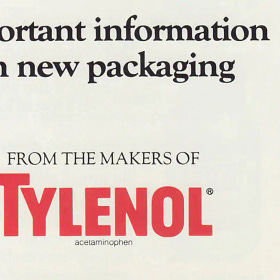“Society in every state is a blessing, but Government, even in its best state, is but a necessary evil; in its worst state an intolerable one.” - Thomas Paine
Surely, far fewer Americans knew what nicotine pouches were prior to last week when Senator Schumer sounded the alarm during a press conference. Referring to them as “pouches packed with problems,” he warned parents that their children may be getting hooked—specifically citing the brand ZYN and the many flavors it comes in—and urged government bodies to investigate immediately. During the event, Schumer’s concerns were echoed by Dr. Mikhail Varshavski:
This product is not part of nicotine replacement therapy as regulated by the FDA.
…early dependence on nicotine during adolescence causes issues with learning, attention spans, proneness to addiction while the brain is in development, so I think it’s very important that these products are regulated very, very carefully.
While it is correct that nicotine pouches are not officially part of nicotine replacement therapy, they have been on the market for years, they are regulated by the FDA, and data emphasizes that they are on the low end of the risk spectrum—posing little risk to adult users, similar to nicotine replacement therapy.1 In addition, while those opposed stress that flavored nicotine products attract youth, are easier to start using, and are harder to quit, it should be noted that many products approved under the FDA’s Nicotine Replacement Therapy framework are also, in fact, flavored. Just take a look at all these delicious names. Cinnamon Surge. Spearmint Burst. Fruit Chill. Yum! Better not let the kids find out.
Setting aside how silly it is that flavors continue to be targeted as if adults don’t have tastebuds, we must get to the true matter at hand. What is the fundamental reason driving hoards of our youths to nicotine pouches? As it turns out, there is no reason—according to available data, what Schumer suggests simply isn’t occurring. Below is the most recent charted data from Monitoring the Future, a continuing study of American youth led by the University of Michigan, showing the percentage of 8th, 10th, and 12th graders in the United States that have used a nicotine pouch in the last 12 months:
If you squint hard enough, you can see usage prevalence amongst 8th, 10th, and 12th graders of 0.6%, 1.9%, and 2.9%, respectively.2 Some would argue that with only one year’s data, historical context is missing, and thus, the (supposedly current) rise in usage is not reflected in this chart above. However, tucked within the results of the same survey is data indicating the exact opposite. For the same period, LIFETIME PREVALENCE amongst 8th, 10th, and 12 graders measured 1.2%, 2,6%, and 3.6%, respectively, but the prevalence of usage in the LAST THIRTY DAYS (also referred to as current use) measured a mere 0.4%, 1.1%, and 1.4%. Simply, prevalence amongst these groups is extremely low.
To further contextualize the above data, we can look at the usage prevalence of other substances. Alcohol usage within the last 12 months for the same cohorts—8th, 10th, and 12th graders—measured 15.1%, 30.6%, and 45.7%, respectively, and cannabis measured 8.3%, 17.8%, and 29%.
Digging deeper, we also see the usage prevalence of amphetamines, cocaine, steroids, opioids, and many more substances that pose acute and irreversible risks. You can explore the data for yourself here. Fortunately, collective usage prevalence for such substances within these cohorts has continued to trend lower over time. However, it should be noted, in aggregate, that the usage prevalence of these substances is still substantially higher than the usage prevalence of nicotine pouches.
Undoubtedly, rather than fostering public outrage over low-risk risk nicotine products with low underage usage prevalence, time and resources would be better spent elsewhere, namely on the long list of pressing concerns that present significant risks to our society as a whole. Efforts to the contrary promote misinformation and continue to foster a toxic state of discourse—the exact phenomenon covered in December’s last piece:
What can’t be ignored
It would be all too easy to dismiss criticisms of novel next-gen nicotine products and assume that regulation would evolve rationally. But regulation always appears two steps behind industry innovation, opposition remains loud, and the machine that oversees the industry in the United States is set for an overhaul, as I penned nearly a year ago:
Changing Gears: A Shift in U.S. Tobacco Regulation
There is not a single nicotine pouch in the U.S. market that has received a Marketing Granted Order. For reference, a relatively similar product category, smokeless (oral) tobacco, has seen products such as Swedish Match’s General Snus SKUs receive PMTAs. Both General Snus and Altria’s Copenhagen have received Modified Risk Granted Orders via the MRTP process. These products pose far less risk than combustible products, but as they still contain tobacco, they carry greater risk than nicotine pouches. All other things being equal, it stands to reason that this would bode well for certain nicotine pouches to pass through the PMTA process and ultimately receive MGOs. However, it remains the case that ever since Brian King became director of the FDA CTP mid 2022, zero new products have received authorization through the PMTA process. Looking at other product types, recent denial orders for e-vapor include closed (disposable) systems, closed and open pod systems, and open tank systems. Even with many manufacturers receiving stays by legally contesting the MDOs, the FDA appears ardent in its roadblock position, and it remains unseen if the administration treats the pouch class any differently as it works through its backlog of PMTAs. In addition, even if certain pouch products find themselves successfully through the PMTA process, further efforts aim to quash novel products. Think back to 2020, when H.R.2339 - Protecting American Lungs and Reversing the Youth Tobacco Epidemic Act passed the house. Lacking further momentum, states have taken measures into their own hands, with California and Massachusetts having banned flavors. Now, flavor bans are advancing through the legislatures of Vermont and Michigan. Various other jurisdictions, including a number of cities and counties, are working toward stricter measures as well.
Nicotine regulation isn’t just at a crossroads. Considering the wide range of potential outcomes on the federal level, state-by-state level, and otherwise, it may be more apt to refer to the present situation as a powder keg. Ironically, those best insulated from a potential blast are the major manufacturers who also produce legacy tobacco products. To prevent misinformation from lighting a match, nicotine intolerance must be combated by pointing to the science, prioritizing education, and steering discourse in a sensible direction. I suspect opposition will remain fiercely led by those who have built entire careers around synthetic hysteria.
If you enjoyed this piece, hit “♡ like” on the site and give it a share. To further show your support, consider pledging a paid subscription to Invariant.
Questions or thoughts to add? Comment on the site or message me on Twitter.
Ownership Disclaimer
I own positions in tobacco companies such as Altria, Philip Morris International, British American Tobacco, Imperial Brands, and Scandinavian Tobacco Group.
Disclaimer
This publication’s content is for entertainment and educational purposes only. I am not a licensed investment professional. Nothing produced under the Invariant brand should be thought of as investment advice. Do your own research. All content is subject to interpretation.
Murkett, R., Rugh, M., & Ding, B. (2022, September 12). Nicotine Products Relative Risk Assessment: An Updated Systematic Review and Meta-analysis.
Miech, R. A., Johnston, L. D., Patrick, M. E., O’Malley, P. M., & Bachman, J. G. (2023). Monitoring the Future national survey results on drug use, 1975–2023: Secondary school students. Monitoring the Future Monograph Series. Ann Arbor, MI: Institute for Social Research, University of Michigan.









Great piece. As a citizen, I’m appalled how authorities (CDC, FDA, WHO, influential politicians) mislead people -- it is clear that vaping, heat not burn and nicotine pouches are much less risky than cigarettes, even though some uncertainty remains about the risks of these newer products.
As an investor, I must take authorities behavior into account. A portfolio approach to nicotine stocks therefore makes a lot of sense, as you’ve previously pointed out.